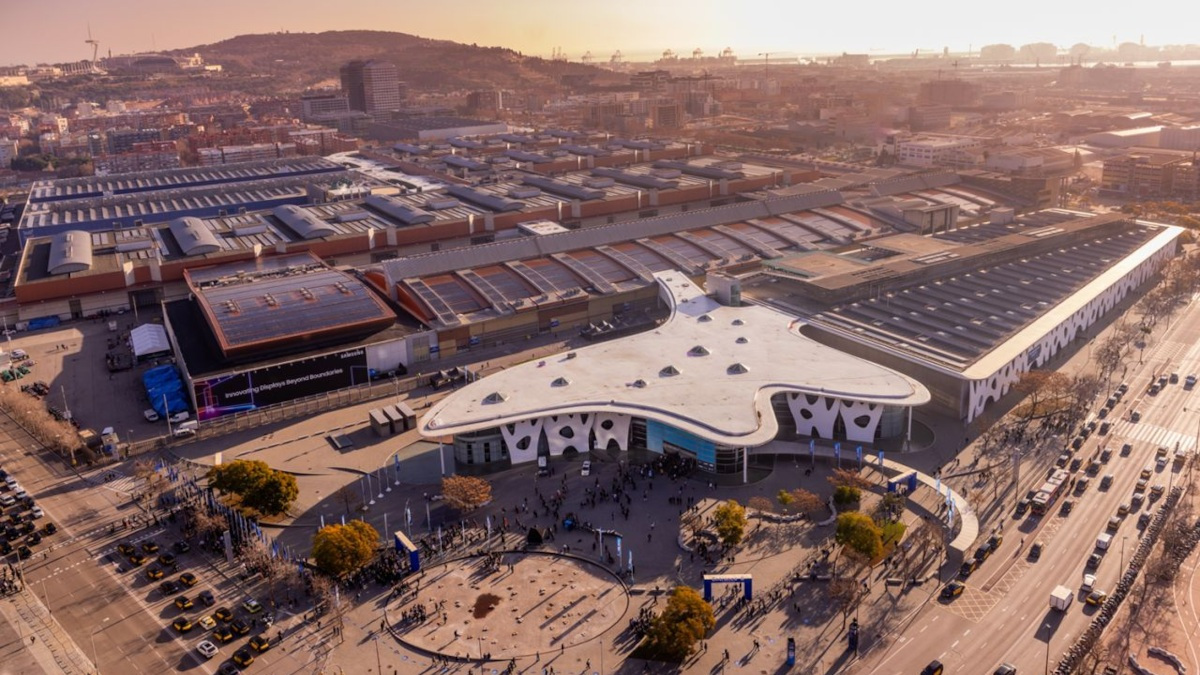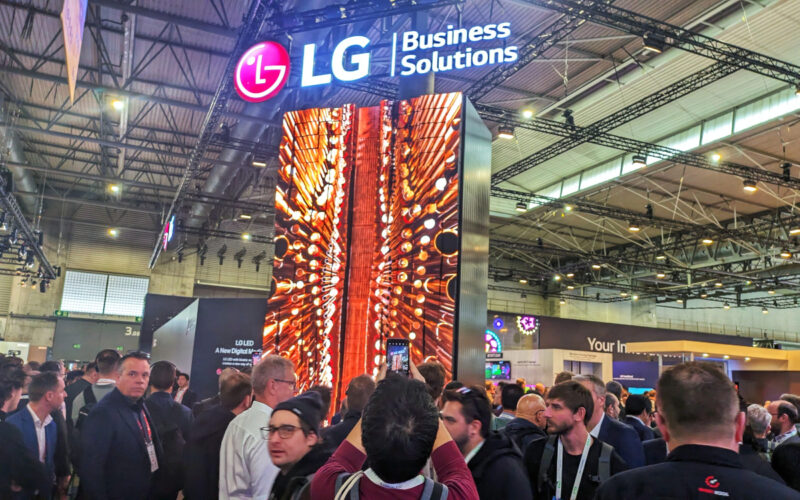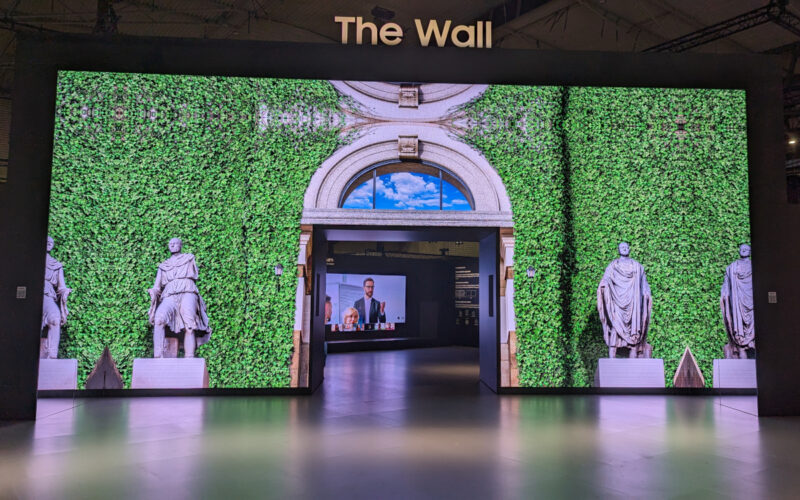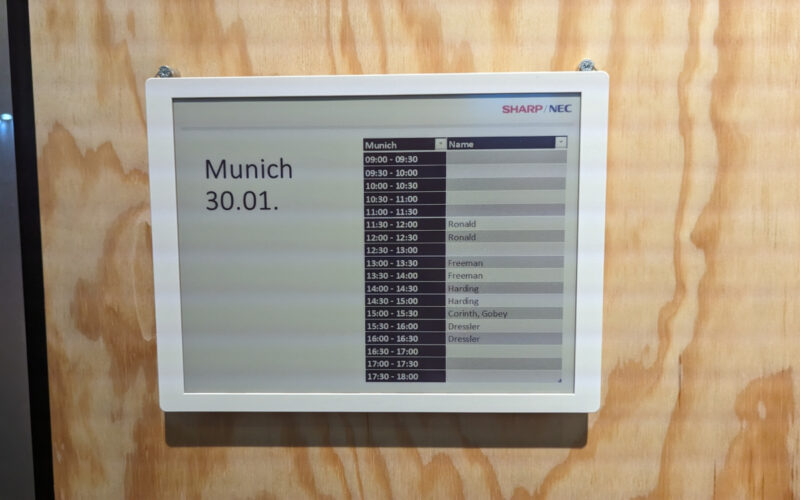Barcelona | From the power of platforms to IOT for B2B: Many of this year’s digital signage innovations are software-based and need to be experienced. The invidis team walked and talked the ISE show floor to screen out 10 trends and drivers for 2024.

ISE 2024: The Top 10 Digital Signage Trends
Amidst the buzz, ISE 2024 stood out as a record-breaking event, attracting exhibitors and visitors alike. Iconic LED installations by industry giants like Samsung, LG, and Lang AG dominated the scene.


These attention-grabbing displays are what defines the first impression a trade show gives. However, many of the real innovations can only be found behind the screen – in product demonstrations at the booths or behind closed doors in whisper suites.
With the industry shifting towards a “software-defined” approach, the most crucial developments were uncovered through extensive interactions and visits to various booths. The invidis team engaged with a majority of the relevant exhibitors, gaining insights into the trends and drivers shaping the landscape of 2024.
These are the invidis Top 10 digital signage trends:
1. Trade shows are back
Can anyone still remember the discussions after Covid about the future of trade fairs? ISE 2024 broke all records and proved that B2B trade shows that have a thought-out concept and a strategic vision are extremely important for manufacturers, vendors, service providers, as well as for buyers.
ISE has become THE global show for the industry, with more than 73,000 visitors from 155 countries. Fun fact: almost half of the visitors at ISE are end-customers (in 2023, end-customers accounted for 42% of all visitors, the 2024 share hasn’t been released yet). Based on our observations, ISE has never attracted so many industry experts from APAC and the Americas, indicating the show is gaining international relevance.
The show floor buzz and the networking atmosphere was overwhelming – in some cases better than the current business sentiment. But trade shows are often a reliable barometer for the business year ahead, so let’s take the vibrant atmosphere of the show as a positive sign for 2024.
2. Platforms
The future of digital signage in general does not (only) depend on advancements in displays and software. It’s about how the industry integrates with an increasingly interconnected technological landscape. To become a B2B mass market, the industry must move away from siloed approaches to technology and solutions. Samsung’s hotly debated VXT which officially launched during ISE fits right into this trend.
VXT is the industry’s first approach to platform economy. This concept mirrors the success of consumer-oriented giants like Apple, Amazon, and Google. These incredibly successfull platforms all offer a global marketplace for third-party apps and solutions explicitly tailored to the platform.
Samsung is not the only digital signage player moving into the platform business. PPDS (Philips) announced the launch of ProStore for Wave at ISE. German Ad-Tech Framen adapted the platform concept to the DooH industry, positioning itself as the bridge between digital signage and DooH. Behind closed doors, several manufacturers have hinted at similar platform concepts slated for future release.
But no one in the market seems as determined as Samsung: despite backlash from integrators and ISVs concerned about disruptions in the value chain, Samsung remains resolute in its platform strategy.
3. Remote Device Management
Remote device management (RDM) is essentially nothing new, but in Barcelona, its significance for business critical operations and sustainable touchpoint concepts became evident. RDM-enabled pre-emptive maintenance not only enhances operational efficiency but also leads to cost savings. Consequently, CMS and RDM will become core functions of the new generation of digital signage platforms.
RDM’s popularity also extends beyond digital signage: Kramer, for example, launched Panta Rhei, a ProAV control platform that combines setup management, control systems, and collaboration solutions.
In addition to manufacturer-agnostic platforms like SignageOS, more and more hardware manufacturers like Dynascan introduce new RDM platforms that support both their own and third-party devices. This shift reflects the need to break down silos, particularly as B2B end-users typically operate a mixed fleet of screens from various vendors. As a result, network operators are in need of a uniform platform capable of accommodating all existing and future screens.
4. Internet of Things for B2B
Beyond VXT, Samsung set another major non-hardware trend: industrial IoT solutions for digital signage. IoT solutions, which have transformed the residential AV market and building automation, offer highly standardized and scalable sensors based on open protocols like Matter, making IoT more accessible.
Samsung’s B2B IoT platform, built on the SmartThings connected home service, allows users to wirelessly control devices, which aims at saving energy and enhancing security. With 285 million consumers worldwide using SmartThings, Samsung is integrating this platform into its professional signage solutions, turning screens and LED displays into IoT hubs that can connect with sensors from various manufacturers.
Despite this integration, there remains a niche for sensor specialists like Nexmosphere that continue to innovate with specialized B2B sensors such as infrared, weight, and lidar sensors. Samsung’s foray into IoT and sensor technology is even expected to benefit those specialists, as the market leader’s promotion of IoT and sensors amplifies their visibility and adoption globally. Moreover, home automation sensors are still limited to standard use-cases.
5. Transparent screens
There was one hardware trend at ISE that was hard to miss: the prominence of transparent LED screens, exemplified by the large Muxwave display at the south entrance of the Fira Barcelona. In an otherwise highly commodotized visual solution industry, transparent screens are the latest trend. Among LG’s transparent OLED solutions there was a new curved display designed for retail environments. Samsung also captured attention with a striking prototype of a transparent MicroLED display. A very similar product was spotted at the booth of the Taiwanese manufacturer AUO.

6. Artificial intelligence
AI was – oh wonder – omnipresent. Less as a hype topic, but more as an enabler for new functions and features. Integration has become more advanced and the use of AI has become more mature. Artificial intelligence is now integrated in almost all new technologies and programs: From detecting screen failures to adjusting the brightness or improving picture quality.
Generative AI was also present in Hall 6 as an enabler for content creation – almost all software developers have integrated GenAI in one way or another. Signagelive, for example, showcased an automated content service using AI-generated moving images and auto-translation, and Intuiface presented an interactive solution that demonstrated the interaction of multiple GenAI platforms.
7. IT security
It has been mentioned many times on invidis, and it cannot be emphasized enough: it is almost impossible to overestimate the importance of IT security. Requirements for appropriate certifications are now standard for larger clients, and more and more digital signage providers are implementing ISO 27001 certification or its US equivalent, SOC 2.
And it is becoming increasingly more difficult to sell hardware “Made in China” in business critical or security critical projects in the West. Consequently, manufacturers are relocating assembly lines to Eastern Europe (e.g., Samsung The Wall, Leyard) or even opting for “Made in Germany,” such as mainboard manufacturer Kontron.
8. Green Signage
At first glance, green signage appeared less prevalent at ISE 2024 compared to the previous year. This observation, however, is misleading. While corporate and ESG initiatives were less emphasized, many newly launched products incorporated Green Signage features. This includes advancements in energy-efficient displays and LEDs, such as Cold LED technology, as well as increased usage of recycled materials and improvements in sustainable manufacturing, packaging, and transport. Especially Scandinavian and DACH-region customers are increasingly specifying “best in-class sustainable solutions”.
PPDS demonstrated with its new QE-line how even highly commoditized solutions like LCD can still be tremendously improved in regards to power consumption. The manufacturer surprised the market with 40-50% reduced power consumption of LCD-screens – ranging from around 100W to 50W depending on size.
9. LED
LED is THE coming technology for digital signage, central in the transition rowards a B2B mass market solution. The latest LEDs offer enhanced energy efficiency and provide full control for switching screens on and off. For instance, Sharp/NEC showcased an electrical ballast management device facilitating complete shutdowns and safe restarts of LEDs.
Furthermore, the pursuit of ever smaller pixel pitches continues: many manufacturers unveiled displays with pitches as small as 0.4 millimeters, and Aoto presented a prototype of a 0.39 millimeter screen.
While LEDs with ultrafine pixel pitches make for spectacular eye-catching displays, the use-cases are currently limited due to costs. Typical applications include security-related command-and-control installations and automotive R&D, where price sensitivity is comparatively lower.
10. E-paper
ISE 2024 was a breakthrough for E-paper displays. The ultra-low-power technology has emerged as a new professional and highly sustainable display category. Numerous visual solution manufacturers showcased large-format E-paper displays in color, both on the show floor and behind closed doors. PPDS led the commercialization of E-paper displays, with the introduction of the Philips Tableaux in 2023, followed by companies like Sharp/NEC.

At this year’s show, PPDS announced a major E-paper contract with Deutsche Telekom, which plans to deploy E-paper-based DooH screens across many of its 300,000 roadside housings, where backlit displays would not have been approved.
The advantages of e-paper make it ideal for various application scenarios. The exciting thing is that many of these applications do not put e-paper in competition with LCD and LED, but rather with printed posters – opening up the digital signage market to millions of new touchpoints.
